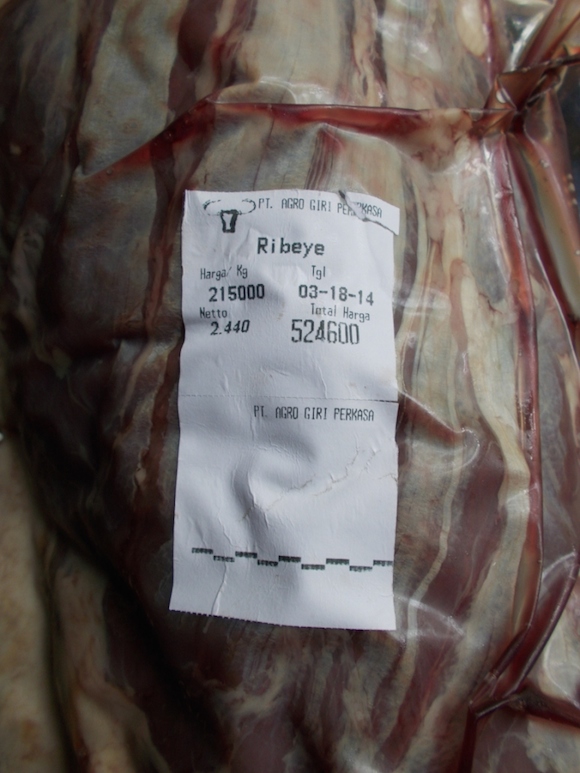Our Indonesian Trip . . . continued
Host: Country Downs Station
Written by Nikki Elezovich – Owner, Country Downs Station.
So I left you yesterday at the end of our relaxing day and having got the go ahead to visit an abattoir that night. After an early dinner and quick couple of hours sleep, we dragged ourselves out of our comfortable hotel bed at about 11pm and headed out to the abattoir with Lisa. I must say that it was amazing! The cattle were brought up the race, one at a time, put into the crush with absolutely no fuss and stunned with the stunner. The side of the race was opened up so the beast could fall down the ramp and the slaughter man could slaughter the beast according to halal tradition. All of this happened in about 5-7 minutes, which is really very efficient. They also had an ‘Animal Welfare Officer’ who basically made sure that each animal was unconscious and slaughtered according to the practices put in place for ESCAS requirements. But what truly astonished us, was the efficiency, both in speed and dexterity, and the cleanliness that each of the butcher’s teams (there were three different butchers at the abattoir when we were there) skinned, quartered, and processed their beasts.
Despite the fact that we have done many ‘killers’ ourselves, we were watching avidly at how these small, but very strong, men were cutting up each beast. A team of about three or four men would only take about 20-25 mins to completely process their beast down to quarters and then maybe another 10-15 mins to process it further to smaller pieces that fit in the back of the ute better! As we were watching, Kurt and I were discussing how it takes over an hour to do what they were achieving in 20 minutes . . . that’s efficient!
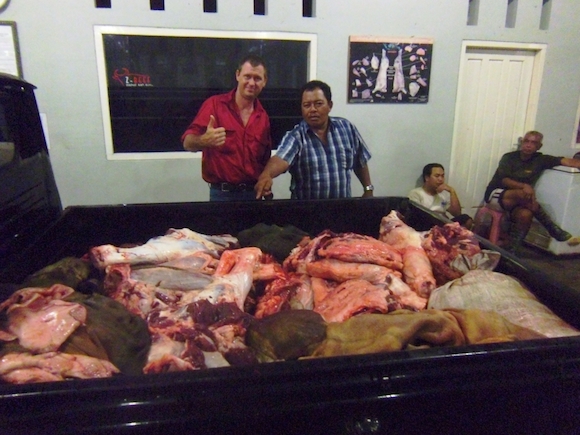 Kurt and Pak Dodo . . . this method is surprisingly similar to the way we do it on the station . . . we just have a larger ute and these days a hiab!
Kurt and Pak Dodo . . . this method is surprisingly similar to the way we do it on the station . . . we just have a larger ute and these days a hiab!
They also did not waste any part of the animal, which is so refreshing to see compared to what we have witnessed back at home. The only part of the animal that was not loaded on to the back of the ute was the contents of the digestive system. All the stomachs and intestines were emptied into drains and washed out completely with water. They loaded the head, hooves, guts, and all other sundry body parts into the back of the ute and drove to their little butcher shop in the wet market.
We also had a fantastic discussion (and therefore laughter at our inept Bahasa Indonesian), with the abattoir manager and other workers and showed them a few photos of our property and the way we do things. They were absolutely astounded at the size and space of what is an average-sized property. They could not believe that we had to travel for over an hour to get to the nearest town and the funniest thing that I remember is that they could not believe that we were able to take a photo of not only one, but over one hundred of our cattle with no fence between them and us.
This night we were especially lucky in that we were able to follow one of the butchers to their stall in the wet market and get a sneak peek at how they go about portioning and storing the cuts of meat. Apparently, the most sought after cut is the head! What we did find out though is that only a few ‘cuts’ sold for a higher price. How it works is that everything on the beast is the same price per kilo, each person comes along and says they will have ‘that piece there’ or maybe “1 kilo of that piece”, so it’s a first-in-first-served scenario, which is why it was so surprisingly busy at such an ungodly hour of the morning . . . around 2am.
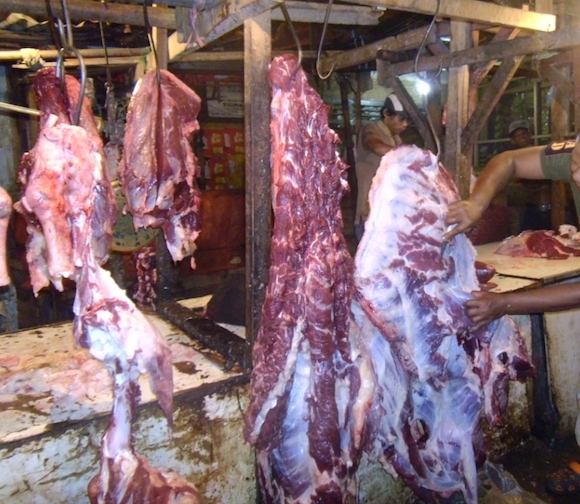 At the wet market . . . very fresh beef!
At the wet market . . . very fresh beef!
After annoying the poor butcher for far too long, we left them to it and went to get more food!!!! This is when Kurt tried the tendon in a nearby Padang Resturant. Much too chewy for me! Unfortunately, the restaurant did not have any more fried skin that evening, so we couldn’t give that a go!
What I loved about this night was that we saw an excellently run, excellently managed, clean, and efficient slaughtering facility that demonstrated to us that these procedures ARE done properly. Now we can honestly say to people that we do in fact know where our animals are going and that yes, we are happy with the way they are being treated and slaughtered.
In fact, I feel that the practices that we witnessed surpassed many of what I have seen in Australia. These lovely people allowed us to watch and observe their facility and I can only hope that we have also given them something in return . . . and that is that not everyone who visits them is there to find a problem with what they are doing. We learnt so much from them in that one night and I feel that if all I can do to repay their kindness and trust is to try and let everybody else know what a fabulous job they are doing, then this is the time and place to do it!
On the 18th March, Lisa had organised a trip to the Elders Lampung Feedlot for us. Once again, this was another very well-run facility that utilised waste products to further their production. They had a very similar set-up, maybe a bit smaller in terms of the crops they were producing, but still involving the re-use and recycling of manure as fertiliser for the crops to be used as feed for the feedlot. While we were there, we actually got to see a group of cattle that are part of a project being undertaken in Australia by Tim Schatz. They had literally arrived a couple days previously and were at the start of the project that was trying to find out if crossbreed (i.e. not pure Brahman) could perform as well in the Lampung feedlot in southern Sumatra as the Brahman do. More information about the project can be found at :
http://www.beefcentral.com/production/f1s-perform-well-in-indonesian-feedlot-comparative-study/
This sums up our stay in Bandar Lampung, Sumatra. However, our ‘holiday’ was not quite over as we jet-setted over to Lombok on the 19th March to catch up with a good mate of ours that we used to work with when we were both in the Pearling Industry. Buzz (our esteemed friend!) is now managing a number of pearl farms off Lombok. We spent rest of the week relaxing, eating great food (lots of gulai kambing aka goat curry), drinking good Indonesian beer and even eating a cut of beef that we bought from AGP in Sumatra and flew with us to Lombok! BTW . . . it was deliciously tender and tasty!
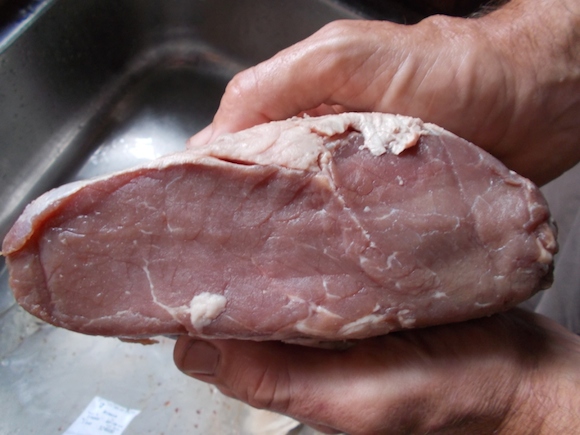 Aussie beef Indonesian style . . . no different really!
Aussie beef Indonesian style . . . no different really!
I even got to wet my feet on the deck of a boat when Buzz showed us around one of the pearl farms he manages, which was fabulous as an unfortunate reality of living on a station is that I don’t get to work on the ocean anymore and surprisingly I really miss being on the water!
Unfortunately, as they say, “All good things must come to an end” and our nine day holiday was at an end on the 23rd March and we had to return home to our normal lives again!
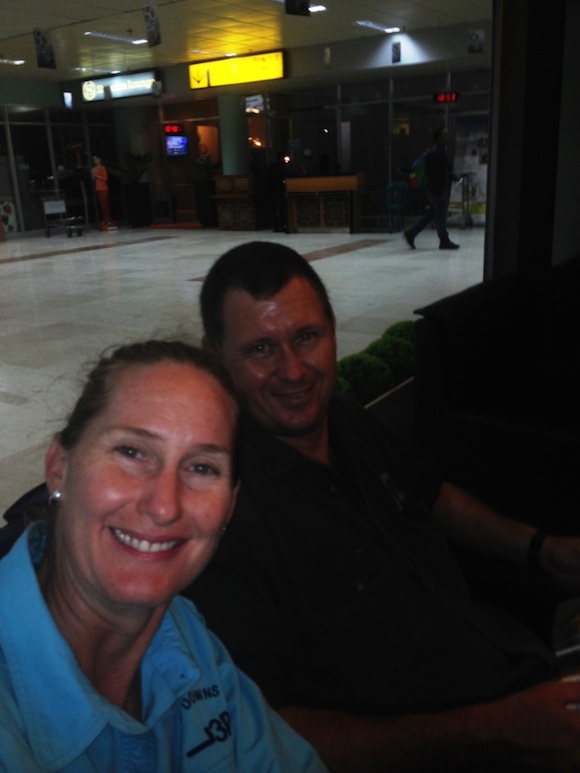 At Denpasar airport waiting to board the plane to take us back to Broome!
At Denpasar airport waiting to board the plane to take us back to Broome!
It was great to come back and see the kids, feel the space, and listen to the silence of nature. We are both so grateful to all the people who enabled us to have such a great holiday. To my parents for taking on such a big job, to Lisa for spending so much of her time and effort in making our trip so eventful, to Buzz for putting up with us . . . uuhhhm I mean . . . putting us up for a few nights and to the lovely Indonesian people that we met and made our adventure so real and worthwhile and also for putting up with our tragic attempts to speak their language . . . many times I recall saying something only to have the person look at me with complete confusion. When I re-read the translation dictionary, I found that I had created a whole new word . . . no wonder they couldn’t understand me!
Anyway, that is it for our Indo trip. Tomorrow you will get to hear about the last year from Kurt’s perspective.
Ciao Ciao, Nikki

